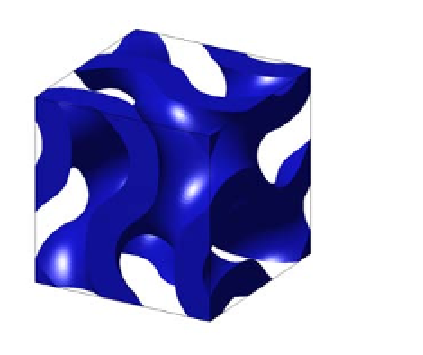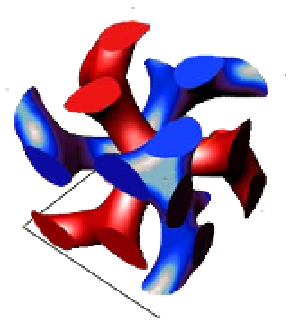Biomedical Engineering Reference
In-Depth Information
An approximation to the copolymer gyroid morphology is
based on the “Schoen G” or “Gyroid” surface — a triply periodic,
infinitely extending minimal surface (i.e., has zero mean curvature)
that divides space into two continuous labyrinthine volumes
without intersections. When this surface is given a finite thickness
by simultaneously expanding two surfaces of uniform thickness
on either side, shown in Fig. 2.16a, space is divided into three
nonintersecting volumes. The “central” volume, centered on the
original gyroid surface, forms a matrix through which run two
distinct intertwining networks, each periodic in all three directions.
The resultant morphology constitutes the constant thickness (CT)
model for the G phase [82]. The BCP G phase is often termed a
double
gyroid
, formed upon segregation of the majority block into a central
matrix volume making up roughly 60% of space, with the minority
component comprising both of the two network phases. A model for
a G phase unit cell with cubic (Ia
3d) symmetry is shown in Fig. 2.16b
with the matrix phase removed and the two networks shaded blue
and red for clarity.
(a)
(b)
[111]
[110]
[100]
Figure 2.16
Models of the gyroid phase. (a) A constant thickness gyroid
model surface. (b) A model for the cubic G phase block copolymer phase
unit cell. The matrix phase is removed and the two network phases colored
blue and red.
The gyroid phase was first identified in diblock copolymers by
two groups in 1994 [82, 83]. Following these first investigations the
gyroid phase has been observed in AB [84, 85, 50] and ABA [86-88]
































Search WWH ::

Custom Search